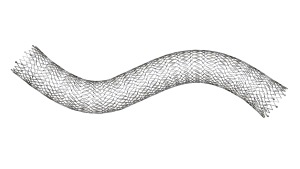This advertorial is sponsored by Boston Scientific.

The VICI Venous Stent System (Boston Scientific) is associated with excellent primary patency rates, with concomitant symptomatic improvement in Clinical-Etiological-Anatomical-Pathophysiological (CEAP) classification, directly after stenting and in long-term follow-up out to 36 months.
This is the headline finding of a subgroup analysis from the Arnsberg Venous registry, recently presented by one of the principal investigators, Michael Lichtenberg (Karolinen Hospital, Arnsberg, Germany) at LINC 2021 (Leipzig Interventional Course; 25–29 January, virtual). These long-term data add to a growing body of clinical evidence in support of the VICI Venous Stent System, and make it the only dedicated venous stent with data out to three years—a crucial edge in a growing field.
The European market for dedicated venous stents is expanding, which has seen a parallel increase in available data. However, Lichtenberg stressed the importance of long-term results. “We are treating very young patients with acute and chronic outflow obstruction, and therefore I think there is a clear need to have long-term data available for this treatment,” he said.
Data show excellent and continued patency of VICI Venous Stent System out to three years

In this context, Lichtenberg focused on the Arnsberg Venous registry, which now has data out to three years. He detailed that this was set up alongside the investigational device exemption (IDE) trial for the VICI Venous Stent System. “The objective of the ongoing, prospective, single-arm, single-centre, non-randomised Arnsberg registry subgroup analysis was to assess the safety and effectiveness in achieving patency of target venous lesion through 36 months post stent placement with the VICI Venous Stent System,” he specified.
The VICI Venous Stent System, Lichtenberg informed the audience, is a self-expanding laser-cut nickel-titanium (nitinol) stent with a closed-cell design that is available in diameters of 12, 14, and 16mm, and in lengths of 60, 90, and 120mm.
In terms of the patients included in the registry, Lichtenberg detailed that they had “clinically significant chronic non-malignant obstruction of the iliofemoral venous segment”. Ninety such patients were involved, comprising 49 patients with post-thrombotic syndrome and 41 patients with compression syndromes such as May-Thurner.

Lichtenberg revealed a “very important” 96% rate of primary patency after 36 months. He also announced positive clinical outcomes, first in terms of the Venous Clinical Severity Score (VCSS) analysis. The patients included in the registry “improved immediately after baseline and stayed very stable through the whole follow-up period,” he informed LINC viewers. CEAP analysis showed that patients improved from baseline to 36 months—a “highly significant” result.
In addition, Lichtenberg communicated that there were very few adverse events. “We had one access-site complication, one haematoma, and five stent reocclusions,” he detailed. Significantly, the investigators did not see any stent migration, venous rupture, infection, or pulmonary embolism during or after the intervention.
Evaluation adds to existing evidence on long-term efficacy and safety
These latest long-term data add to a growing body of evidence on the long-term efficacy and safety of the VICI Venous Stent System.
In 2018, 12-month outcome data for 75 patients from this registry was published.1 In this study, the VICI Venous Stent System placed in the iliofemoral vein segment in patients with symptomatic venous outflow obstruction revealed no safety issues, had excellent primary patency, and substantial symptom improvement.
Furthermore, Lichtenberg compared the present results to those of the already-published VIRTUS IDE trial, which showed similar results.2 In this IDE trial, 12-month primary patency was 84%; after 24 months, this was 79.4%. Patients also improved significantly during follow-up in the VIRTUS trial.
In a growing market with an expanding pool of data, the focus is now on longer follow-up, and this is where the VICI Venous Stent has an edge. The Arnsberg Venous registry subgroup analysis revealed excellent efficacy and safety out to 36 months, adding vital long-term data to an already established efficacy and safety profile. Concluding, Lichtenberg informed LINC viewers that this stent is “a very good option for the treatment of acute and chronic outflow obstruction”.
References
- Lichtenberg M, Breuckmann F, Stahlhoff WF, et al. Placement of closed-cell designed venous stents in a mixed cohort of patients with chronic venous outflow obstructions – short-term safety, patency, and clinical outcomes. Vasa 2018;47(6):1–7.
- Razavi MK, Black S, Gagne P, et al. Pivotal study of endovenous stent placement for symptomatic iliofemoral venous obstruction. Circ Cardiovasc Interv 2019;12:e008268.
 CAUTION: The law restricts these devices to sale by or on the order of a physician. Indications, contraindications, warnings and instructions for use can be found in the product labelling supplied with each device. Products shown for INFORMATION purposes only and may not be approved or for sale in certain countries. This material is not intended for use in France.
CAUTION: The law restricts these devices to sale by or on the order of a physician. Indications, contraindications, warnings and instructions for use can be found in the product labelling supplied with each device. Products shown for INFORMATION purposes only and may not be approved or for sale in certain countries. This material is not intended for use in France.
2021 Copyright © Boston Scientific Corporation or its affiliates. All rights reserved.
PI-968301-AA










